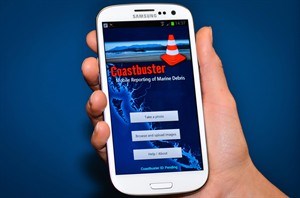
The Coastbuster app for the Android operating system is shown in this November 28, 2012, handout photo. With more than a million tonnes of debris from the Japanese tsunami floating toward North American shores and beaches, a new app is encouraging members of the public to become "citizen scientists" and help track the wreckage as it arrives. THE CANADIAN PRESS/HO - Coastbuster
January 02, 2013 - 10:12 AM
VANCOUVER - With more than a million tonnes of debris from the Japanese tsunami floating toward North American shores and beaches, a new app is encouraging members of the public to become "citizen scientists" and help track the wreckage as it arrives.
Some of that debris, washed out to sea in March 2011 after a magnitude-9.0 earthquake triggered a massive tsunami, has already washed up along the West Coast of Canada and the United States, but the bulk of the wreckage is yet to come.
When it does, researchers at the University of Victoria want anyone who happens upon a piece of the wreckage to pull out their smartphone, snap a photo and record what they see using a new app called Coastbuster.
"It allows any managers, whether it's local government, provincial or state government, to actually begin to plan how they're going to clean it up," says Kate Moran, president of Ocean Networks Canada, a research group based at the university.
Ocean Networks developed the free Coastbuster app, which is currently only available on Android phones, though an iPhone version is in the works.
The app allows users to take a photo of large debris on the coastline, especially items they believe may be from the Japanese tsunami. They can then describe the item, its composition and its size using a short form before sending it back to Ocean Networks.
The information then goes into a database that can be accessed by local governments and the U.S.-based National Oceanic and Atmospheric Administration. The photos are also posted to a special Flickr feed for the app.
Moran says the information will allow governments to co-ordinate local clean-up efforts, as well as help identify potential invasive species that may have hitched a ride on the debris.
Researchers also hope the data will tell them more about ocean currents.
"These data are important for understanding ocean circulation and current patterns, because these big large things have a certain buoyancy and are sitting in the water column at a certain depth, and you begin to understand how it got here and what path it took," she says.
The tsunami, which left more than 18,000 people dead or missing, washed about five million tons of debris into the ocean.
Most of that sank immediately, but an estimated 1.5 million tonnes did not. Scientists still aren't sure how much remains afloat after nearly two years.
Reports of tsunami debris began early last year, but it's difficult to confirm whether something actually came from the Japanese tsunami. As of Dec. 13, the National Oceanic and Atmospheric Administration had received 1,432 debris reports. Of those, only 17 have been confirmed to have come from the tsunami.
Those reports are expected to increase in the coming months.
Moran says her group hopes to use the app as a model for other projects that could rely on the public to report what they see.
"If there was a change of species on the coast, you get could citizen scientists to help document that change," she says.
A group of volunteers on Vancouver Island that surveys debris on the region's beaches plans to use the Coastbuster app during its monthly beach cleanups.
Cara Lachmuth, who is a member of the Vancouver Island chapter of the Surfrider Foundation, says she hopes the Coastbuster app encourages the public not only to pay attention to beach debris, but also clean it up when they see it.
"I think a lot of the time people feel really disempowered and this is such an easy way to get involved and see what's happening to our coasts," says Lachmuth.
Lachmuth says her group has come across debris with that appears Japanese, but it's not clear whether any of that is from the tsunami.
Last year, volunteers with the group found a refrigerator with Japanese writing on Vargas Island, off the western side of Vancouver Island near Tofino, but determined it had been there for three years.
"We'll find a toothbrush with Japanese writing on it, and we do try to get these things translated to make sure they're Japanese, but stuff has always been coming over from Asia and it's really hard to say, 'It's from the tsunami.'"
—With files from The Associated Press
___
On the web: www.oceannetworks.ca/coastbuster
News from © The Canadian Press, 2013